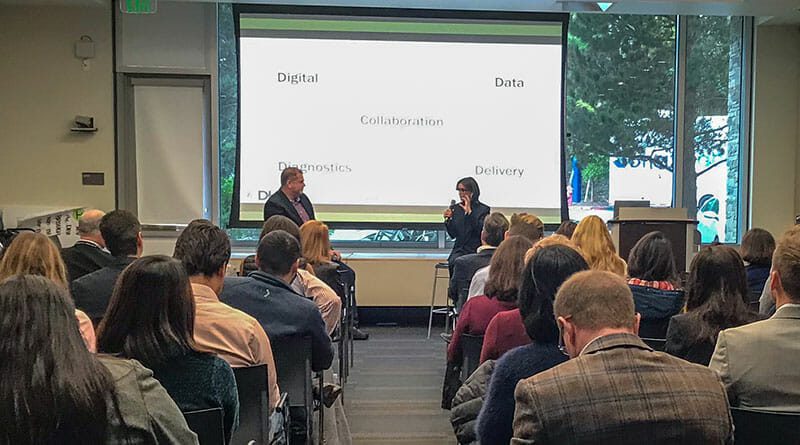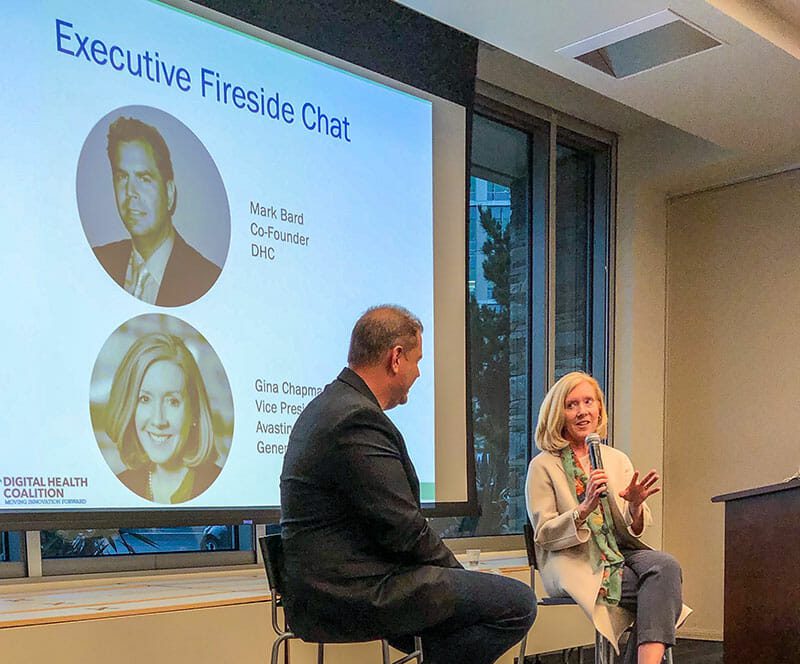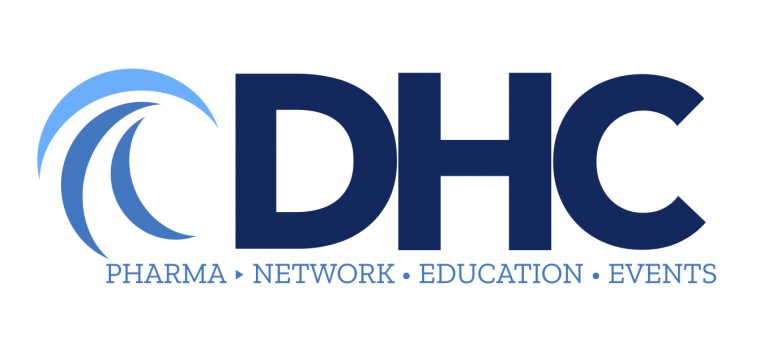DHC West Coast Summit Key Takeaways | Genentech Campus | November 2019
Source: Roche
Key Takeaways from the Sessions
Keeping this “pivotal moment in healthcare history” as a backdrop, the overarching theme of the day was focused on precision medicine and providing customer experience in the biopharma industry. Specifically, the role biopharma plays in the engaging and fostering relationships ‘beyond the pill’ with their customers, both consumers (i.e. patients) and healthcare providers (namely, physicians) was explored from myriad angles.
The event was kicked off with opening remarks by Sharon Dotson, Genentech’s Senior Director, Digital Customer Experience, whereby she declared “We, here at Genentech, are obsessed with our customers’ experience,” helping to set the stage for the presentations and panel discussions.


Marketing in a Precision Medicine World
- Nearly all physicians (89%) agree, science will produce more personalized medications over the next 5 years, and 67% agree precision medicine will greatly improve outcomes in the next 2 years. However only about one in three (35%) medications today are designed for the biology of their patient. For precision medicine to have a real and remarkable impact priority needs to shift from general ‘one size fits all’ medicine of today to personalized care.
- Digital, data, diagnostics and ultimately delivery are finally starting to converge, and never has collaboration been so critical to providing an exceptional patient experience and patient care.
- While 69% of physicians polled agree patient in-home self-testing provides patients with information about their risks of getting a disease, and 50% of physicians have reviewed home-based tests or information from patients, only 34% have recommended a home-based test to patients, leaving an opportunity for further education in this space. On a positive note, only 11% have discouraged patients from using home-based tests to help them make health decisions.
- Ultimately, the challenge of moving to more personalized medicine is that the current healthcare environment, including systems and processes, are not set-up for precision at every step. Even the best efforts at the physician-patient interface are likely to fail until everyone along the delivery chain adopts the transition and the infrastructure is put in place.
Intelligent Tracking Prevention (ITP) is here… The Future of Data Privacy … Why It Matters
- A somewhat recent initiative by Apple launched in June 2018 (and Mozilla in late 2018), ITP is having profound impact across the full marketing technology stack. Any company that provides, measures or relies any of the following: Targeting, Re-Targeting, Frequency Caps, Audience Modeling, Post Site Visit Tracking, View Through Conversions, and any Advanced Analytics will certainly feel the impact, if they haven’t already.
- ITP completely blocks cross-site tracking of 3rdparty cookies and limits the lifespan of 1stparty cookies (currently 24 hours) on the Safari and Firefox browsers, meaning advertisers cannot watch, categorize or track users as they move from site to site and publishers cannot tailor their visitors’ experience or track them beyond a 24 hour period. While Google hasn’t yet adopted a similar policy for Chrome (GTP), and it is unclear whether they will, given they are an ad supported network, the concern is that if they do, visibility into all web visitors would become limited.
- If these industry-driven initiatives, ITP and the threat of GTP, weren’t enough to cause for concern, GDPR out of Europe and a recent California legislative initiative called California Consumer Privacy Act (CCPA), coming online in 2020 require companies to seek consumers explicit acceptance of cookies. More than 20 US states have similar legislation moving through various stages of approval.
- Given these dual priorities of protecting consumer privacy and curbing consumer targeted and measured advertising, what is a marketer to do? First, acknowledge that these changes are having an impact of the way ad campaigns are run. Second, reduce your reliance on 3rd party cookies, instead opting for more 1st party data, relying on contextual placements and change measurement from cookie-based to panel based. Third, in the short term, rely on Chrome as a proxy for measuring campaign performance. Finally, push measurement partners to acknowledge the gap and make adjustments to fix it.
Digital-First Strategy and Customer Experience
- Best practices that have been refined in other industries and should be considered within pharma: 1) Keep the information simple and concise 2) Be respectful of the individual’s communication preferences by letting the consumer decide when, how and where the communication should occur 3) To the extent possible, enable or at least support a self-serve model – consumers have been trained to feel they are in control even when they are being guided 4) Respect their boundaries, protect their data, while keeping the message personal and targeted (i.e., know your customer).
- 62% of C-Suite Life and Sciences Executives say “We don’t sell products/services … we sell an experience.” Customer Experience is their #1 initiative.
- The reality of today’s pressures calls for an evolution from brand to an enterprise approach. Every customer interacting with biopharma is expecting more from the digitization of other industries.
- Ultimately, an “authentic self-service experience,” beyond the medication, with cross channel personalization with optimized media, drives engagement and support. It’s a combined effort with patients and HCP, rely on your partners to fill gaps.
Digital Video Trends
- Video killed the TV Star — Pharma TV spend is up 65% in past 5 yrs (5 billion in 2018 alone). This is highest percentage of any vertical, which makes sense when you think of audience distributions and pharma’s attempt to generally reach older consumers. However, viewers are evolving — TV viewership is down 50% over the past 5 years by Gen Z, while over any given 24 hour period today 500 million YouTube videos were viewed. While Gen Z are savvy consumers, cordless audiences are being driven by Gen X: The ‘Cord Cutters’ are finally outnumbering ‘Cord Nevers’.
- Authentic high-quality content that truly connects, that people want to be a part of drives engagement. While TV is passive, and digital is active, YouTube has become massive: reach is 60% of the population – users spend 54% of their video-viewing time on videos 20 minutes or longer.
- On YouTube, the amount of time spent watching ads is 24% longer when they find the content creator is trustworthy – Brands are recognizing that focus on content and solid story telling is becoming table stakes
- Three aspects of high-quality content that are making an impact: Have a clear mission with clear goals, developed for platform approach, and aligned with culture – the moments that matter
Customer Experience & The EHR
- Even with all of the effort and initiatives around interoperability and standardization, EHR data silos still exist in 2019, often leading to greater inefficiencies, fragmented information and double data entry.
- The advent of relying on a ‘medical scribe’ at the point of care might offer one solution that might help support with some of the inefficiencies, while also improving the quality of the HCP-patient experience.
- What do physicians want from an EHR system? Well, everything in one place, but more specifically, co-pays, coupons, real-time access to formulary – all without “swiveling” between devices. Further, physicians prefer clinical messaging to brand messaging alone. One best practice: incorporate brand message in context of clinical messaging.
- From the perspective of the physician, the biggest challenge currently facing current EHR landscape is simply, usability. Hospitals still provide greatest opportunity for improvement. However, one solution alone will not accomplish all expectations – diversification and partnering will be required.
Physician Experience in a Shifting Landscape
- Consolidation has changed the face of the physician landscape in the US — nearly 2/3 of physicians were in private practice, after consolidation, now it is closer to 1/3.
- 274 = the number of MDs any US physician will need to collaborate with in a given year; while only about 1/3 of specialist will get the reason for the patient’s visit prior to the consultation. 64% of doctors say they have less free time than when they started practicing medicine. Every 3.5 years, the entirety of medical knowledge DOUBLES.
- All oncologists do not consume information the same way: 47% are attracted to jargon and technical detail that spark their academic curiosity; 25% are focused on the nuts and bolts of the information that relate to their practice; while 28% are skimmers, opting to avoid overly technical language and looking for just highlights or lists.

- When engaging the modern physician, it is good to remember: 1) “Native gets, shorter keeps” their attention 2) Tailor to their preferences, keeping it personalized and relevant 3) Physicians are people too—layer information and leverage video to increase retention of key information 4) Finally, never forget … Doctors have a low tolerance for tech that doesn’t deliver.
Customer Experience at the Point of Care
- 59 seconds = the amount of time spent by doctor discussing a new Rx with patient … of total of 16 minutes total spent during a visit. Understanding what patients, providers and other key stakeholders are experiencing and their mindsets at the point of care provides visibility into what the care experience is like and is invaluable for brands to create effective messaging during that precious 59 seconds.
- Understanding what patients are saying, seeing, hearing, thinking, feeling while they’re at the doctor’s office is so important to a brand’s success because it’s here – where treatment decisions are ultimately being made and scripts are being written.
- Proper solution design recognizes the pressures and all the players, and works with all those involved to support the connection between doctor and patient with the right education and tools. What they all have in common is a shared goal of a better outcome. Physicians have their own stressors… this must be appreciated when putting together a POC brand campaign.
- Messaging best practices at the Point of Care 1) Several things that you want to be sure NOT to do: Don’t interrupt workflow, assist it; don’t place players in opposition, help support alliance; don’t subvert choice 2) We can always be guided by: what is my highest purpose – how can I be most helpful here? Don’t show before you know; don’t speak until you’ve listened; don’t ask people to do, until you’ve got them all aligned.
Closing the Day
Gina Chapman, VP Rituxan, Herceptin, Avastin at Genentech closed the day with her thoughts on precision medicine, customer experience, and organizational dynamics to promote innovation, teamwork, and overall success.
Thanks to the team at Genentech for hosting the DHC West Coast Summit. For more event summaries, check out the DHC Events page.

